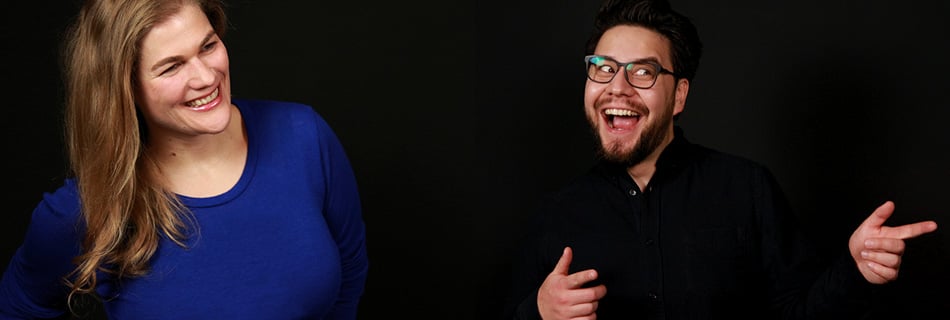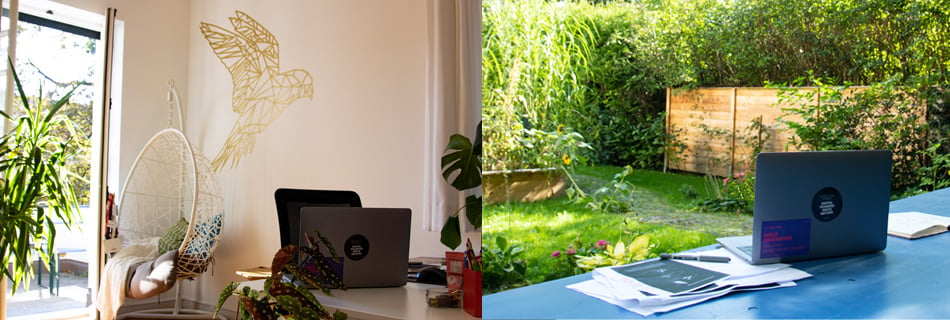An Interview With the Authors Catharina and David

To start with the most obvious question: What is Connect the Dots about?
Catharina: In essence, it describes the principles of how we at innosabi understand innovation. In everything we do, we start with the assumption that innovation is for the most part a collaborative effort and a matter of combining the right information or people. Based on this assumption, we have created different approaches for organizations who want to pursue their own innovations and transformation in such a way. The book lays out our thinking behind all of this and also gives hands-on advice for via exemplary case studies and recommended actions.
David: To add to what Catharina said, the book – at least for me – is also about finding a clear narrative and common threats in today’s “buzzwordy” innovation landscape. At innosabi, we always try to see bigger picture and not get lost in the nitty-gritty discussions on which innovation method is the “best” or which framework to follow diligently. To us, they are all part of a common theme, which we try to describe in Connect the Dots.
Ok, can we get a short answer as well?
Catharina: Sure! Connect the Dots is about enabling innovation by creating and nurturing the right connections.
David: Or as I like to call it: “The innosabi Hitchhiker’s Guide to Innovation Ecosystems”.
It’s now been a couple of years since you published the first innosabi book Crowdsourced Innovation. What made you decide to write another one? After all, it’s a lot of additional work on top of your usual responsibilities.
Catharina: The first book is a snapshot of our methods and ideas from a time when we were primarily focused on innovation and collaboration with end users or consumers. Since then, our approaches and methods – and also we as a company ourselves – have evolved. So it just made sense to put it all down in a second book. We also wanted to explore the topic from a “higher”, more strategy-focused perspective as a supplement to the first, much more practice-oriented book.
Can you share a little bit about the inception of the book? How did it all start to take shape?
David: The idea to write a second book started a while back. I don’t really know when exactly. Catharina and I were still sharing an office back then. We couldn’t really see each other because the desks were arranged head to head and we were hidden behind our screens. But we were always sharing a lot of ideas or observations about the changing role of innovation in companies, the different methods that emerged, and where innosabi was heading. It was like playing “idea ping-pong” across the screens. At one point we just said jokingly “Hey, we should write a book about that!”. It still took quite a while to go from there to actually start writing the book, but I guess it was clear for both of us right away that this was something that we really wanted to do.
Speaking of “actually writing” the book: how did you work together? Did you divide the chapters up between you two or was everything a joint effort?
David: I think it evolved very organically from our previous “idea ping-pong” into pretty much the same mode but with arguments being actually written down.
We would talk about our ideas first, take notes, exchange them and refine them until I was able to put them into long-form writing.
Then the draft for each chapter went through the same process of sending it back and forth until we were both happy with them. Also, our design team Julia Gackstetter, Mona Sardari and Pia Weizenegger started to join the collaboration process very early on, so the content, the layout, and the design really complemented each other along the entire way. That’s why it’s not just a cover with pages full of text in between but rather a piece of meticulously crafted art.
The book includes many different best practices, case studies, and quotes from renowned experts and industry leaders. This requires close cooperation with others. How did that work?
Catharina: The partnership with our customers is characterized by a constant mutual exchange of knowledge. Of course, we also find out immediately when a customer has made new progress or is exploring new forms of innovation methods. Such successes are celebrated and shared together. The same applies to our network. Having people as supporters who share our ideas about innovation was crucial for innosabi’s successful development. In our network we always exchange ideas, develop them further, and learn from others. It was only a small step to take this to the next level and put it into writing for the book.
Which section of the book is most important to you personally?
Catharina: Since I love to see in our daily business, what our clients are doing with our tools and methods, I enjoy the customer cases. They take our ideas and thoughts and turn them into something tangible, which is just amazing. I am very proud that so many companies became a part of the book by sharing their unique stories.
David: For me personally, the chapters at the beginning are very important. They are the once, in which we describe why the topic is important and on which principles we base our methods and approaches. It is, so to speak, a little “innsoabi manifesto” that we have never formulated in such a way before.
And which parts were the most fun writing?
Catharina: The chapter on corporate culture was a great pleasure to write – while we were writing it, I thought a lot about our own culture at innosabi and also tried to incorporate these personal experiences into the chapter. So it has actually become a hidden declaration of love to the innosabi team – but don’t tell anyone 😉
David: For me, it’s the same as answer as to the question before. Quite simply because in daily business there is little time to think about and refine the foundations from ground up or to look at the things we do from a bird’s eye view.
Where were your favorite spots to get some writing done?
Catharina: I have to admit that I can work very focused and in quiet at my usual desk in the office. But all over our office – which we call the “Innovation Mansion” – there are many spots and quiet place where I can work equally well if I need a change.
David: It might sound weird, but I think I wrote most of the book in the basement of our office… It’s quiet, spacious, cool during the summer, has some comfortable armchairs, the shortest distance to our in-house bar, and it’s a bit detached from the usual hustling and buzzing of the normal offices.

How does it feel to hold the first printed copy in your hands?
David: On the one hand it’s of course very exciting and just beautiful to see it come to life. On the other hand, there is also a lot of relief that we are finally done with. Just like after the first book, we can agree that “Let’s never do this again sometime.”.
Catharina (laughs): The perfect last sentence!
